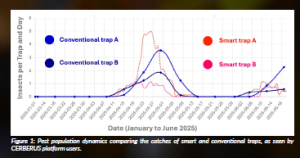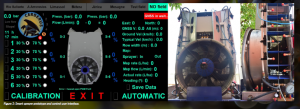Francisco Rovira-Más, Ilaria Filippetti & Menelaos Stavrinides
Between 20% and 40% of global crop production is lost to pests annually. Each year, invasive insects cost the global economy around $70 billion, according to the Food and Agriculture Organization of the United Nations (2023). While up to 40% of global crop production is lost to pests, acute hunger has grown in 2024 for the sixth consecutive year, according to the 2025 Global Report on Food Crises. As a result, pests are a real and permanent threat to food security and farming sustainability.
Generally speaking, the problem of pests can be divided into two categories: quarantine pests (QP) and established pests (EP). The Horizon Europe CERBERUS project (2024–2027) faces both of them with two diverse strategies. The strategy for reducing the threat of quarantine pests is early detection, whereas the goal for fighting established pests is the deployment of intelligent sprayers that reduce pesticide use while maintaining the efficacy of pest control in a sustainable way.
The diversity and specificity of agricultural pests, crops and their interaction, however, would make the problem unapproachable in practice. Therefore, to reach definite results that can make an impact on end-users, the CERBERUS scope is limited to a 33 approach, understood as three crops x three quarantine pests x three established pests. The three crops chosen are among the most relevant for Mediterranean agriculture: wine-producing grapes, oil-producing olives and fresh-market oranges.
The project runs six pilot fields, two per crop and per country, in the following distribution: vineyards in Italy and Cyprus; olive orchards in Spain and Italy; and citrus groves in Cyprus and Spain. The following paragraphs describe the methodology envisioned to fulfil both objectives and review the results achieved over the first 18 months of the project.
In general, quarantine pests are absent from a defined territory or present but not widely distributed. However, they are destructive and therefore pose a significant threat if they become established and spread. In CERBERUS, the QP for oranges is the Asian fly (Bactrocera dorsalis), which is not present in Europe; the QP for vineyards is Flavescence dorée, which is present in Italy but not in Cyprus; and the QP for olives is Xylella fastidiosa, which has devastated the olive production of Southern Italy but has only been detected in almonds in Spain.
Combating quarantine pests benefits from early detection and large scale. They are two conditions that can exist separately, but together increase the chances of success. CERBERUS tackles large-scale issues by merging plots from multiple users, the area coverage of Sentinel satellites and the granularity of citizen science through the use of a cloud-based platform. Early detection requires continuous monitoring, and the five-day revisiting time offered by several Copernicus bands brings opportunities for noticing stress at early stages. The challenge comes at the time of differentiating whether the cause of stress is biotic (pest and diseases) or abiotic (lack of nutrients or water).
CERBERUS faces the challenge of disentangling biotic from abiotic stress signals with ground sensing, in particular with smart insect traps and robot-based proximal sensing. Quarantine pests are difficult to work with due to stringent regulations and their frequent absence from the studied territory. The Asian fly, in particular, is the quarantine pest for citrus in CERBERUS, yet it is not present in Europe (except an isolated outbreak in the Campania region in 2025). Therefore, developments related to their monitoring and detection require collaboration with institutions beyond project beneficiaries.
Flavescence dorée and Xylella fastidiosa are QP diseases tracked in CERBERUS through their vectors. For every insect caught, however, national authorities require certified laboratory confirmation that the insect is a disease carrier. This poses a complexity for smart trapping devices, as the sticky paper roll must halt its automatic movement if a vector is identified by the AI engine analysing the image sent from the field. Given the devastating effects of QP, early detection is the safest countermeasure. In particular, the project cloud platform will combine initial signs of canopy decline from Copernicus satellites, the presence of relevant insects from traps, high-resolution canopy traits with proximal sensing and potential outbreaks at unexpected sites as revealed by involved citizens.
The first 18 months of the CERBERUS project (January 2024 to June 2025) have led to advances in several areas. A network of over 60 traps—half smart traps and half conventional ones to validate the smart ones—was established and connected through a cloud platform in 2024, providing easy access to partners.
Special emphasis has been placed on the user-centred design of the cloud platform to ensure that non-experts can easily access Copernicus satellite imagery. Once users (currently pilot coordinators and researchers) provide a field location, the platform automatically tailors and delivers relevant crop-sensing images for that plot. This eliminates the often insurmountable task of locating, cropping and downloading the correct image segment from official sites.
Considerable effort has gone into selecting and rendering the most relevant vegetation indices for each crop–pest combination. For example, in vineyards affected by Flavescence dorée, the platform displays NDVI (normalised difference vegetation index), MARI (modified anthocyanin reflectance index), and NDMI (normalised difference moisture index) for red grape varieties. For white varieties, it instead shows NDVI and plant senescence reflectance index (PSRI).
Similarly, for olive orchards monitored for Xylella fastidiosa, the platform displays optimised soil-adjusted vegetation index (OSAVI), green normalised difference vegetation index (GNDVI) and blue normalised difference vegetation index (BNDVI). Users do not need to configure these settings manually; the platform selects the appropriate indices based on the crop and variety provided during plot registration.
Citizen science activities began in 2025 with educational events in Cyprus, Italy and Spain. The activities aimed to provide citizens with the basic tools and knowledge to detect pests in areas that fall outside the monitoring scope of CERBERUS pilots. Citizens, fortunately, committed to perform weekly assessments over the entire season, using the cloud platform to report their findings.
Established pests pose a fundamentally different problem, which opens a very different set of challenges and opportunities for development. They require solutions and approaches that must be aligned with sustainability, circularity and food security. Unlike QP, established pests are present, active and causing permanent losses to farmers. The three EP pests tackled in CERBERUS severely damage fruits, ruining oranges, wines and olive oil. To make things worse, global warming has even aggravated the situation in the last decade.
CERBERUS takes a realistic approach: EP will persist, and there will be a continued need to spray them, at least in a reasonably near future. The solution envisioned in the project is the deployment of smart sprayers that offer greater precision than state-of-the-art blast sprayers. These devices can adjust spray rates in real time based on vehicle speed and canopy size, log critical data to verify pesticide savings while maintaining biological efficacy, and operate through an automated system that requires only basic driving input, eliminating the need to adjust pressure gauges and nozzles manually.
The CERBERUS cloud platform’s ability to tailor satellite images to specific plots will be instrumental in generating prescription maps. These maps will eventually be uploaded to the smart sprayers to ensure appropriate application rates, avoiding the need to regulate machines that typically grow in complexity as technology advances.
The project’s 2025 challenge for EP control is the deployment of four smart sprayers across the pilot sites: one in Spain, two in Italy and one in Cyprus. Each sprayer controls six nozzle sectors—three on each side—and adjusts spray flow electronically using pulse width modulation (PWM) technology. A robust GPS receiver initiates treatment automatically when the vehicle enters a field, adjusting settings to the crop. For example, in vineyards, the system disables upper nozzle sectors 3 and 4 to reduce drift.
While each technological component of CERBERUS is powerful on its own, the project’s true strength lies in the intelligent integration of precisely coordinated field data. Satellite images representing typical remote sensing indices, even those automatically cropped to the field of interest, are not important for the majority of speciality crop producers. However, pest risk maps that combine early stress symptoms from satellite imagery with reliable insect catches from traps and citizen observations will probably be useful for all kinds of potential users, from small farmers to large wineries to government policymakers.
The same principle applies to the smart spraying strategy to sustainably contain EP. Prescription maps that combine updated canopy volume from satellites, infestation rates from traps, the phenological state of crops from user registers in the cloud platform, and fruit presence from scouting robots will likely match spray delivery to canopy needs more accurately. Interestingly, this cross-fertilisation of data will not only be instrumental for CERBERUS users, but for many institutions working with remote sensing platforms that would greatly benefit from well-established measuring systems linked to the field as a ground-truth model validation resource. For such a case, the versatility of the CERBERUS cloud platform becomes the flagship for data sharing outside of the project, with first initiatives programmed for 2025.
Project summary
CERBERUS enhances crop health and food security in olives, wine and citrus by targeting key quarantine and established pests. A cloud-based platform integrates satellite imagery, smart traps, sensors, and citizen data to generate risk maps and spraying prescriptions. These are automatically delivered to smart sprayers, enabling precise, sustainable pest control across multiple Mediterranean pilot sites.
Project partners
The CERBERUS consortium, coordinated by Universitat Politècnica de València (ES), includes Università di Bologna (IT), Eratosthenes Centre of Excellence (CY), Science for Change (ES), NTT Data Spain (ES), smart trap developers EFOS (SV), Valencia Plant Health Service (ES), sprayer manufacturer Cleyfer (ES), and six pilot plots from end-users: vineyards Vinestories (CY) and Laudav (IT); olive grove San Gervasio (IT); citrus farm CPPC (CY); and NACAR (ES), with a citrus plot and intensive olive orchard.
Project lead profile
Professor Francisco Rovira-Más obtained his PhD in 2003 at the University of Illinois. He has been a member of the Intelligent Vehicles System group at the John Deere Technology Center (Moline, USA) and the JD Agricultural Management Solutions unit (Urbandale, USA). Rovira- Más is a professor at the Universitat Politècnica de València and director of the Agricultural Robotics Laboratory. He was the technical manager of EU project VineRobot and coordinator of EU H2020 project VineScout.
Project contacts
Professor Francisco Rovira-Más Camino de Vera s/n. 46022 Valencia, Spain.
Email: frovira@upv.edu.es0
Web: agriculturalroboticslab.upv.es
Funding disclaimer
This project has been funded by European Union’s Horizon 2020 research and innovation programme – grant agreement number 101134878.
Views and opinions expressed are however those of the author(s)
only and do not necessarily reflect those of the European Union. Neither the European Union nor the granting authority can be held responsible for them.
Figure legends
Figure 1: Pest population dynamics comparing the catches of smart and conventional traps, as seen by CERBERUS platform users.
Figure 2: Smart sprayer prototype and control user interface.



